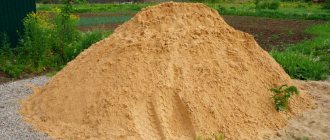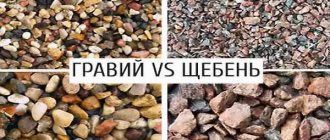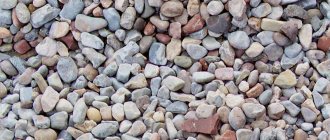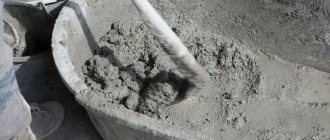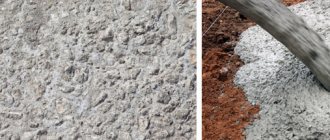It is perfectly stored in the open air on special sites (alluvium maps), a high level of filtration helps excess moisture drain back into the river. Using heavy earthmoving equipment, the storage areas are being embanked. During transportation and storage it does not require special conditions and is excellent for construction and installation work of any level of complexity.
Quarry sand fractions are also actively washed to remove impurities and biological residues using special devices. Washed and artificially seeded sand from a quarry may be less clean than alluvial sand, as a result of which its quality suffers. This determines the scope of application at landscaping sites, preparation of building mixtures without special quality requirements. Any additional washing of sand extracted from quarries entails an increase in production costs. Only cleaning allows us to obtain high-quality construction raw materials.
Extraction and washing of alluvial sand
Alluvium of sand from
We extract bulk building materials using hydromechanical equipment as a specialized sand reclamation company . The material extracted by hydraulic excavation has the following characteristics:
- Color yellowish/grayish
- foreign impurities up to 0.5%
- The percentage of dust and silt inclusions is 3-11%
- Sand grain size by fraction
- Fine-grained 1.6-2.4 mm.
- Average 2.4-2.6 mm.
- Coarse-grained 2.0-5.0 mm.
- Filtration coefficient from 3 to 20 m/day.
- For fine-grained fraction 3-15 m/day.
- For medium particles 5-20 m/day.
- Natural density 2000-2850 kg/m3
- Bulk density 1300-1550 kg/m3
Cost: 100 rub/m3
In terms of purity and characteristics, washed quarry sand is similar to sand mined from the bottom of a river. However, the reclamation of sand from quarries makes it possible to reduce the cost of this material as much as possible.
Description
Sand is in demand in the construction industry as an important component of mixtures and as a basis for road embankments. Due to the high content of clay and other impurities, the raw materials extracted from sand quarries are not able to ensure the strength of concrete coatings and structures; they clog the equipment. Washing sand with water cleanses the bulk material from debris, clay and soil additives, and improves quality indicators.
“Vodoroy” is a specialized company providing sand reclamation services. We extract non-metallic materials by open-pit mining using professional hydromechanical equipment. The sand that we propose to extract, thoroughly cleaned under water pressure, acquires all the properties necessary for the preparation of high-quality concrete solutions and finishing mixtures. It becomes homogeneous, small, and free-flowing, which allows it to be used in the construction of buildings and roads. Excellent moisture permeability and can be used in water purification systems.
In addition to alluvium in sand quarries, sand is extracted from seas, lakes, and rivers. Natural material is sucked up by pumps from the bottom of reservoirs and washed during the extraction process. All types of sand extracted by alluvium contain a small amount of impurities and have excellent performance qualities.
Types of alluvial sands
Based on their origin, there are 3 varieties: quarry, river, sea . Natural material is sucked up by pumps from the bottom of reservoirs and washed during the extraction process.
All types of sand extracted by alluvium contain a small amount of impurities and are distinguished by excellent performance qualities. They are used for various road works and in housing construction:
- Quarry alluvial sand is used in the industrial production of bricks, concrete, concrete mixtures, road surfaces (tiles for sidewalks, curbs, road slabs). Added to masonry mortar, installation and construction mixtures. Used in the production of painting and grouting compounds. Used as a base for laying concrete and asphalt pavements and embankments.
- River/lake sand with a particle size of 1 mm to 3 mm is suitable for use in concrete and plaster mortars, forming drainage systems, and making glass. Like quarry, it is used for laying roads.
- Sea sand is used in the production of high-strength reinforced concrete products and is part of dry construction mixtures.
Pure quarry aggregate is the most affordable. This is due to the prevalence of sand quarries, proximity to the place of application, and ease of extraction. River oil costs more, is mined in smaller volumes, and requires higher transportation costs. The high cost of sea water is explained by increased quality, shortage of production, and transport costs for delivery from the sea coast.
Order sand washing now with a 10% discount
The sand reclamation company “Vodoroy” provides services for the development of sand deposits using the hydromechanization method. A high degree of purification of bulk material is guaranteed by the use of high-performance equipment, qualifications and experience of personnel. You can order the reclamation service online using a special form on the website. Receiving professional advice and placing an order are also available by calling the company's telephone numbers.
You can order the service online - just use the special form on the website. You can also get professional advice and place an order for services by calling the company's telephone numbers.
Source: https://vodoroy.ru/vidyrabot/dobycha-pgs/namyv-peska.html
Why is owner control important?
I deliberately did not include the salary of a hired manager in expenses. Why? Because there are cases when, surprisingly, in the same quarry, where the owner gives the reins to the site manager, so to speak, who is not vitally interested in the result, production immediately drops for some reason. Is there a way for a business owner to “get rid” of the need for such strict control over his employees? Today there are companies on the market offering various control systems specifically for the quarrying of non-metallic building materials.
A firm NO to theft of diesel fuel!
This way, you can install a remote fuel consumption monitoring system on any diesel dredger, which will show all refills and expenses on the screen of your home computer.
The possibility of diesel theft at the bunkering stage (underfilling), as well as at a subsequent time (draining), is immediately eliminated. If there is no reliable reception of a GSM signal, the system can be equipped with a satellite data transmission unit. Installing a fuel consumption monitoring system on an LS-27 type dredger will cost around 0.5 million rubles, the payback period depends on the scale of the disaster.
How much is my dredger washing now?
To control sand production by volume, there are local devices that record production and store the results in memory. You can see how many cubic meters the dredger pumped per shift onto the alluvial map on the screen, or you can take readings onto a flash drive and analyze it on a computer. Installing the device on an existing dredger within Russia will cost 0.7 million rubles.
Remote systems that transmit data via the Internet to your computer or smartphone and are equipped with more accurate sensors based on a radioisotope emitter are much more expensive - about 1.5 million rubles. However, you can monitor your business online from anywhere in the world while going about your business. The system interface is somewhat similar to a car’s tachometer, only in this case it records not kilometers, but cubic meters of sand mined and placed on the map by your team.
Source
Washed sand
/ Technologies /
The material was prepared with advisory support from specialists from StroyKomplekt JSC.
Construction sand according to GOST is a bulk material with a grain size of up to 5 mm. In order to improve quality, it is sometimes enriched with gravel up to 3 mm in size. It must be safe and belong to class 1 radioactivity. Reaction with water and alkali is not allowed.
How is quarry sand extracted?
Alluvial sand is mainly used. for construction purposes and drainage.
Washed, seeded sand is homogeneous in structure, but has inclusions of salts, humus, and particles of plant roots, which is worse than other types of building materials.
For this reason, it is used for building mixtures and drainage when landscaping areas where high quality is not required. Sometimes it is washed with hydromechanical devices in order to obtain a building material of higher quality, but also more expensive due to additional energy costs.
A place for storage and storage of sand extracted using hydraulic alluvium - alluvial map. The spreading of water beyond its limits is prevented by a shaft made of local soil. Diking is done with bulldozers and excavators.
: Smokehouse from the refrigerator: we study in detail
Features and options for using washed sand
It is called washed because it actually goes through a thorough process of washing away various unnecessary impurities that may be unnecessary during a certain series of works. As a result of painstaking work and special equipment, you can obtain clean material, without residues of clay, dust and various other granules. The color of washed sand can range from gray to yellow. The average grain size in this case will be 2 mm.
PREPARATORY WORK
2.1. The design of the coastal dump should provide for the following main work performed during the preparatory period:
— removal of the fertile soil layer and removal of peat;
— fixing in nature the boundaries of the territory and water area of the coastal dump, installing boundary and direction signs;
— engineering preparation, including the planning of the territory (site), the transfer of existing underground (underwater) and ground (overwater) networks, the installation, if necessary, of temporary or permanent roads, power supply networks, lighting and communications, safety fencing signs;
— installation of measuring rods on alluvium maps.
2.2. Preparatory geodetic work should include:
— creation of a reference geodetic network and a geodetic base;
— removal and fixation on the ground of the design axes of enclosing dams and spillway structures;
— installation and fastening of the main and working reference signs of the geodetic alignment base, linking them to the state plan-altitude network;
— installation of tide gauges and water gauges and linking them to the main support signs;
— attaching measuring rods to reference marks on alluvial maps.
2.3. To determine the water level of the water area in the area of the coastal dump, it is necessary to use a port tide gauge, the accuracy of the readings of which must be ensured in any sea state.
2.5. In accordance with the requirements of SNiP 3.01.01-86, a construction organization project (POS) is drawn up, which includes all the work of the preparatory period. Based on the PIC, the contracting organization develops a work plan and technological maps for the supply and placement of soil into the coastal dump.
Washed sand: characteristics, production methods and application
The material was prepared with advisory support from specialists from StroyKomplekt JSC.
Construction sand according to GOST is a bulk material with a grain size of up to 5 mm. In order to improve quality, it is sometimes enriched with gravel up to 3 mm in size. It must be safe and belong to class 1 radioactivity. Reaction with water and alkali is not allowed.
Application of washed sand
Washed sand is widely used in the production of paving slabs; production of concrete mixtures of special strength; in drainages; glass production; creating rings, blocks and other concrete products; landscape design. Often added to concrete mixtures, screeding compounds, paints and plasters. When using sand mixtures yourself, you should choose concrete of at least grade M300 and clean water. To make the solution set faster, plasticizers are added to the composition. Fine-grained quarry sand is used in road construction, to create drainage and as a base layer.
Alluvial sand particles are usually no larger than 0.6 mm, which makes it possible to use it for plastering work, laying high-quality road surfaces, and making concrete and bricks.
In private construction, the use of expensive sand is necessary for particularly durable structures: foundations, fences, monolithic walls, columns, park paths, swimming pools, fountains and others.
Alluvial sand is widely used in construction.
Modern construction requires high-quality natural materials. Well-washed particles do not stick together or form lumps. Washed sand should be stored in places with low humidity and without strong wind. Otherwise, some of the sand will deteriorate. You can put the sand mass in canvas bags or bags. Sand is packaged in 25 and 50 kg.
Prices for sand depend on the type (river, washed, seeded), filtration coefficient, as well as on the distance of the quarry from the place of sale, and the volume of purchase. Delivery is often included in the price. Coarse sand is cheaper because it is easier to process.
SUPPLY OF SOIL TO THE COASTAL Dump
4.1. The laying of distribution slurry pipelines should be carried out after the completion of the construction of enclosing dams and spillway structures.
4.3. The following schemes for supplying soil to the coastal dump are recommended:
a) the hold of a self-hauling dredger - refuler station - coastal dump;
b) the hold of a self-hauling dredger - refuler station - pumping station - coastal dump;
c) the hold of a soil hauling scow - a coastal dump (double transshipment);
d) the hold of the soil hauling scow - scow reloader - coastal dump.
The choice of technological scheme for supplying soil to the coastal dump in each specific case must be carried out on the basis of a feasibility study, taking into account the availability of technical means, the distance from the site of soil development (dredging) to the coastal dump and safety measures during reloading operations.
4.4. When supplying soil to a coastal dump according to schemes a
and
b
(see clause 4.2) the refuller station must be installed on a berth structure that ensures the safety of mooring the dredger and the performance of refuler work.
4.5. The design of the mooring structure must be designed for the load from mooring the dredger, the effects of waves and ice in accordance with the requirements of SNiP 2.06.04-82.
4.6. It is recommended to select the area for installing the refuler station taking into account the conditions of protection from wave action.
The choice of the location of the refuler station should provide conditions for the safe maneuvering of dredgers and soil hauling scows during mooring operations.
4.7. Work on refilling soils into a coastal dump using a self-propelled dredger (diagram a
or
b
) must be carried out in accordance with the requirements of RD 31.74.08-85.
When refilling soil into a coastal dump with a stationary dredger (diagram in
) it is necessary to comply with the requirements of SNiP III.-8-76.
4.8. When supplying soil to a coastal dump with double transfer, approaches to the deposit must be equipped with navigation aids in accordance with the requirements of RD 31.74.08-85.
4.9. The planned dimensions of the deposit's water area and depth should ensure safe navigation and maneuvering of dredging vessels. The minimum linear size of the deposit in the plan must be at least two lengths of the dredging vessel.
4.10. Development of a pit for the installation of a soil deposit is recommended only if there are no areas of the water area with natural depths that would accommodate the estimated volume of soil.
4.11. The estimated deposit capacity Vd is determined by the formula
Buy alluvial river sand in bags
Sapropel
– an environmentally friendly, soil-forming fertilizer, which is mined at the bottom of freshwater, stagnant reservoirs. Sapropel is a multilayer deposit formed from plant and animal residues.
Sapropel is considered a universal fertilizer that is suitable for any plants and is used on all types of soil.
How to recognize real, high-quality sapropel
Sapropel is a unique fertilizer, but sometimes, instead of real and high-quality sapropel, scammers can sell heavy lumps that feel like plasticine, dark gray in color, sometimes with a bluish-whitish tint and an unpleasant, musty odor.
It is important to know:
- the seller must have all the necessary documents for the goods, which must indicate where the product was mined and its composition;
- it is important to know what sapropel should look like.
Characteristics of sapropel:
- The color depends on the composition; the highest quality product has a dark, almost black color. Sometimes there are gray, gray-blue, brown, olive, pink and even red colors of sapropel;
- In air, the color of sapropel quickly fades;
- It feels light, moist and crumbly (if the sapropel is liquid or jelly-like, it means it contains ferrous compounds and is not ready for use);
- The consistency is similar to ash, but a little heavier;
- Has a slight odor of hydrogen sulfide;
- When dried, sapropel becomes very hard, almost like stone.
engages in the sale and delivery of sapropel, which has the appropriate documentation and meets all GOST standards and sanitary standards, because Our specialists carry out strict quality control in special laboratories.
Products are always in stock, delivery is carried out around the clock by our transport, or if necessary, you can arrange pickup and pick up the goods yourself. Our company works on holidays and weekends, we are ready to advise you at any time.
Composition and varieties of sapropel
Sapropel has a very rich composition, it contains:
- macro- and microelements (potassium, calcium, copper, zinc, iron, manganese, boron, etc.);
- humic and fulvic acids;
- growth stimulants (fiber, proteins, amino acids);
- various vitamins (A, B2, B5, B12, E, etc.);
- beneficial microflora (ammonifying bacteria, bacilli, and fungi of the genus Trichoderma).
There are no harmful microorganisms and pathogens in the composition of sapropel. The percentage of one or another component in sapropels extracted from different places can vary significantly. The composition of sapropel depends on its location and variety.
Depending on the component that predominates in the chemical composition, sapropels are divided into:
- Carbonate;
- Siliceous;
- Organic;
- Ferrous.
Depending on the ash content, sapropels are:
- low ash (ash content less than 30%);
- medium ash (30–50%);
- high ash (50–70%);
- high-ash (70–85%);
- silt (more than 85%).
Type of sapropel Composition in %
| Organic matter | Ash | Nitrogen | Phosphorus | Calcium | Magnesium | |
| Low ash | 80 | 19 | 3,4 | 0,14 | 2,5 | 0,5 |
| Srednezolny | 60 | 38 | 2,6 | 0,18 | 2,3 | 0,7 |
| High ash: | ||||||
| clayey and sandy | 37 | 63 | 1,9 | 0,19 | 2,7 | 1,5 |
| calcareous | 40 | 60 | 1,6 | 0,14 | 16,0 | 1,2 |
| High ash (lake lime) | 26 | 73 | 1,2 | 0,18 | 34,0 | 0,8 |
| Il: | ||||||
| clayey and sandy | 12 | 88 | 0,6 | 0,17 | 4,5 | 1,3 |
| calcareous | 13 | 87 | 0,6 | 0,15 | 15,0 | 2,3 |
Useful properties of sapropel
- increases productivity and improves fruit quality;
- has a positive effect on the growth and development of plants;
- promotes the development and strengthening of the root system;
- nourishes plants with beneficial microelements;
- promotes long flowering;
- strengthens seedlings, improves their survival rate;
- improves the structure of the soil and increases the humus content in it;
- increases the water-holding capacity of the soil, which allows you to save on watering;
- helps to completely restore soil fertility in 3-5 years;
- neutralizes the effect of nitrates and pathogenic microflora accumulated in the soil.
Sapropel extraction
There are 3 types of sapropel locations:
- residual lake;
- peat bog;
- quagmire.
Sapropel can be found in almost any swampy area, but such a product will contain too many harmful chemicals. The best places to extract sapropel are considered to be reservoirs with clean, running water, rich in vegetation and living creatures.
Sapropel is extracted using special equipment - dredgers and excavators. Then the material extracted from the bottom of the reservoir is dried, otherwise rotting processes may begin in it. Dehydrate sapropel until it turns into dry, granular material. The dried product is then sold. Most often, the process of preparing sapropel
Areas of application
- Agriculture: production of fertilizers, land restoration, growing seedlings, etc.;
- Livestock: Used as a feed additive for animals;
- Medicine: used in the form of mud and applications for medicinal and cosmetic purposes;
- Industry: manufacturing of sorbents.
Growing seedlings
Mix sapropel with soil in a ratio of 1:3 and you will get valuable soil for growing seedlings.
Planting lawn, flowers and vegetables
Before sowing lawn, flowers, vegetables and other crops, dig up the soil with sapropel to a depth of 10 cm at the rate of 3 liters of fertilizer per 1 m2. This will improve seed germination and increase yield.
Planting trees and shrubs
Before planting fruit and berry crops, mix sapropel with soil in a ratio of 1:3 or 1:6, pour the resulting soil into the planting hole. Sapropel-based fertilizer will ensure better growth and development of trees and shrubs, as well as improve the quality and increase the quantity of fruits.
Fertilizing and mulching
Using sapropel as a top dressing, it should be sprinkled around the plant with a layer of about 2 cm, around the trees with a layer of 5-7 cm. After this, it is necessary to loosen the soil and then water it abundantly. You can use sapropel fertilizer 1-3 times a season.
For indoor plants
Mix sapropel with soil in a ratio of 1:3 or 1:4. Thus, you will receive valuable soil for indoor plants, which will protect them from various diseases and pathogenic microflora.
Restoring soil fertility
If your site has problematic and depleted soil, for example, sandy or clayey, it is not necessary to remove the top layer, and every year you can enrich the depleted soil with peat or black soil; you can restore it with sapropel.
Sapropel must be distributed over the site at the rate of 3 liters per 1 m2 and the soil must be dug to a depth of 10-12 cm. Thus, sapropel will restore, improve and nourish the soil for 3-5 years, saturating it with useful microelements.
TECHNOLOGY OF WATERING SOILS INTO A COASTAL DAMP
5.1. When the coastal dump is located on land, soil reclamation on each map must be done in layers. Alluvium of each subsequent layer should be carried out after the soil of the underlying layer reaches the strength adopted in the project.
5.2. When determining the volume and thickness of each layer of reclaimed soil, the formation of three zones in the coastal dump should be taken into account: beach, intermediate and pond. It is recommended to adopt the following ratios of zone sizes by area for a concentrated one-sided pattern of alluvium of loamy and clayey silts:
When mining gold
In this mining method, sand is a secondary raw material that appears during the development of gold ore.
The process of gold mining can be divided into several stages:
- Geological exploration
- Gold ore mining
- Separation of gold from rock
Now let's look at each stage in more detail.
Geological exploration
At this stage, geologists estimate the volume of gold that is in the ore. Experts use complex methods and, of course, no one has used vines to search for gold-bearing veins for a long time. But we will not go into details (this is far beyond the scope of this article), but will speak only in general terms.
The main indicators of the presence of precious metal in rocks are:
- River lowlands
- Presence of quartz deposits
- Contents of pebbles and black sands
Gold ore mining
So, in the gold mining industry there are three methods for extracting ore:
- Career
- Shakhtny
- Drazhny
Let's look at each below.
Career
This method is a technology that involves the development of primary gold deposits. Rock masses are first blasted, and then pieces of rock are collected using excavators, bulldozers and dump trucks. Next, the destroyed ore is crushed into particles of different sizes using special machines. The resulting raw materials are transported to gold extraction factories.
Shakhtny
Not all gold is on the surface. Most of the primary deposits lie in the bowels of the earth. Therefore, in this case, the mine method is used. Using special equipment, workers drill mines, prepare them for the movement of people and machines: they build elevators, railway tracks and equip lifts for transporting ore.
Next, deep holes are drilled in the monolithic rock into which explosives are placed. These wells can reach 30 meters. Their depth is determined by geologists and engineers. After the explosion, the destroyed ore is raised to the surface, where it undergoes a crushing process. And then, as in the quarry method, they are sent to a gold recovery factory.
Interesting fact: mines in which gold is mined can go hundreds of meters into the ground. And the underground infrastructure of the field can reach several tens of kilometers. For example, one of the shafts of the Yuzhnaya mine, located in the city of Berezovsky, Sverdlovsk region, has a depth of 416 meters.
What is a dredger
The vessel, which is what this type of equipment is, is equipped with a pump, pipeline and other equipment necessary for normal operation.
Important
The high performance of such mechanisms is achieved through the integration of modern satellite navigation systems and all kinds of sensors that make it possible to determine the position of the soil intake and achieve maximum productivity in any conditions.
The power of domestically produced amphibious machines varies from 150 to 3 thousand cubic meters of pulp; imported analogues can be characterized by much higher power, but the price of such dredgers is much higher than that of Russian models. In addition to floating dredging units, there are land-based ones.
They are placed on railway platforms, on tractors or on special trailers. Stationary installations are also available on the modern market, which are pumping stations that allow increasing the height and distance of transportation of the water-soil mixture.
Design
From a structural point of view, an earth vacuum cleaner consists of the following functional elements:
- Main nodes. These include a soil intake mechanism, pipelines, a soil pump, and parts that move the soil intake.
- Auxiliary elements - the ship's hull, special mechanisms for immersing and lifting it, water supply pumps, power plants.
- Features that ensure safe operation and proper performance.
How special equipment works
The operation of the dredger is based on a soil pump - a powerful abrasive-resistant pumping device. In the vast majority of cases, it is installed in the hold to avoid cavitation, which significantly shortens the service life of the mechanism. The device functions as follows:
- Careful calculations are made of the optimal feed rate of the soil mixture and the permeability of the pipeline.
- Water is poured into the soil pump, it descends into the reservoir and reaches the bottom.
- The motor starts, the gearbox turns on.
- Air is pumped out of the pipe.
- A vacuum is formed, allowing water and soil to enter the pipeline.
- The slurry is fed into a pump and transported either to shore or to a cargo barge.
The system moves on stilts or winches. Some models use a combined movement system.
The dredger is controlled from the wheelhouse, and the operator, the dredger, is responsible for it. It is he who manages all the functions of the machine, from turning on the lighting fixtures to the operation of the main equipment.
Rent
The earth vacuum cleaner is in great demand in the service market. These devices make it possible to establish the extraction of non-metallic materials from river beds and quarries surrounded by water. In addition, they are indispensable during dredging work, and, thanks to the use of the hydromechanization method, when soils are simultaneously developed and transported, the entire range of required activities is carried out much faster and with minimal financial costs. Using earth vacuum cleaners, as mentioned above, water bodies are cleaned of silt deposits.
In this regard, renting a dredger is of particular relevance, as it allows you to quickly cope with the task at hand, entrusting all the concerns regarding its solution to the specialists of the company that owns such highly specialized equipment.
Types of earthen shells
There are several types of dredgers - suction dredgers, multi-scoop dredgers, grab dredgers and rod dredgers.
- The most widely used are suction-type dredgers, the design of which includes pumping equipment that pumps out eroded soil through a pipeline.
- Multi-bucket dredgers are characterized by the presence of a chain of links with buckets. After turning on the motor, the buckets begin to move, collect the soil mixture and transfer it to a conveyor or tray.
- Grab shells are non-self-propelled machines with cyclic action, which are mounted on the platform of a floating crane. The main working tool of such devices is a grab, which is a bucket with jaws that rotates around its axis.
- Rod dredgers are a kind of excavator mounted on a floating platform. All operations are performed with a bucket or a long crane boom. Such projectiles are widely used when performing various types of excavation work at shallow depths.
Dredger for cleaning reservoirs
In the vast majority of cases, cleaning water bodies from bottom sediments is only possible with the use of suction dredgers. Such equipment sucks up sludge and water through a powerful soil pump and delivers it under high pressure through a pipeline to soil-carrying barges. It is also possible to transport sludge to a sludge map created before the start of treatment work.
The silt map is a specially designated area fenced with a high earthen rampart. The area of the map depends on the area of the reservoir and the estimated volume of sludge that is planned to be removed. If small-area reservoirs need bottom cleaning, mini dredgers are attractive - compact and fairly maneuverable devices with high productivity, capable of performing a wide range of channel cleaning tasks.
Before starting cleaning, it is necessary to study the specifics of the sediments and the profile of the reservoir, create a map, remove debris and metal debris from the bottom, if any, measure the depths, and develop a project for performing the work. It is important to determine in advance where the withdrawn sludge will be disposed of.
